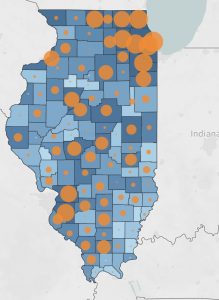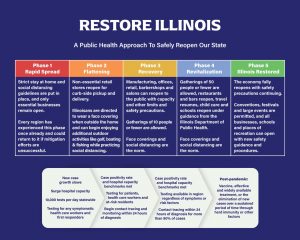Mitigations triggered in 9 of 11 Illinois regions as COVID-19 rages
By Jerry Nowicki Capitol News Illinois — October 29, 2020
Gov. J.B. Pritzker takes questions at his daily COVID-19 briefing in Chicago Thursday, Oct. 29. (Blueroomstream.com)
SPRINGFIELD – A ninth of the state’s 11 COVID-19 reopening regions triggered increased mitigations Thursday, Oct. 29 as the governor touted the release of federal funding for businesses affected by pandemic-related closures and some legislative Democrats called on the administration to do more for those businesses.
The announcement that Region 3, which includes Springfield and several surrounding counties, would be subject to mitigations including prohibition of indoor service at bars and restaurants starting Sunday, Nov. 1 came as hospitalizations again hit second-wave highs and the state again announced its single-day record for new cases with 6,363.
Officials again warned the second wave looks increasingly like it will be worse than the first which peaked in April and May. As of Wednesday night, Oct. 28, 3,030 people in Illinois were reported hospitalized with COVID-19, including 643 in intensive care units and 269 on ventilators.
“And we can see in these numbers the consequences of rising case rates and hospitalizations and ICUs and ventilators across our state from weeks ago,” Gov. J.B. Pritzker said at his daily COVID-19 briefing in Chicago. “And unfortunately I’m afraid we can expect worse to come. Deaths from COVID-19 are up 82 percent since the beginning of October, when we were averaging 23 lives lost each day. Now, at 41 lives lost each day.”
The governor’s office said hospitalizations for COVID-19 have increased 73 percent since Oct. 1, while ICU bed usage has increased 61 percent and ventilator usage 63 percent from the same date.
Republicans in recent days have pushed back on bar and restaurant closures, requesting the governor share more in-depth data on contact tracing that shows closing bars and restaurants will help curb spread.
“One of my major complaints is that I think the governor has focused so much on the health side of COVID, and has neglected the economic cost of COVID, time and time again,” state Rep. Tim Butler, R-Springfield, said in a news conference following the governor’s COVID-19 update.
He was joined by other lawmakers from Region 3 who said they have requested contact tracing data but have not received it. Butler said he tested positive for COVID-19 on Saturday but has not been contacted by any contact tracers.
They argued the main spreader of the virus is private gatherings, which cannot be regulated. They called on Democratic legislative leaders to reconvene the General Assembly, and they also called on the governor to work with lawmakers.
Pritzker on Wednesday said the state would start sharing contact tracing data in the coming days.
The governor’s office distributed a graphic on Oct. 20 showing 2,300 of 17,939 contacted COVID-19 positive individuals said they had been at a bar or restaurant within 14 days prior to diagnosis. That was second to 2,639 in the category of “other,” which included social gatherings such as weddings, parties and more. The governor’s office said the report included data from 69 of 97 health departments.
While Pritzker said it is often impossible to pinpoint where people were when they caught COVID-19, “what we can tell is if you have multiple cases that were in a certain place at a certain time,” which could point to an outbreak.
Dr. Emily Landon, an associate professor of medicine and the executive medical director for infection prevention and control at University of Chicago Medicine, said masks are proven to be effective in fighting the spread of COVID-19, but “bars and restaurants are one of the few places where people congregate and they can’t really wear a mask and eat and drink.”
“Shutting down bars and restaurants and putting in mask mandates changed the trajectory of the pandemic in Arizona, Texas, Florida, San Diego, Washington, D.C., Illinois, I could go on,” she said. “This isn’t the fault of any particular restaurant. In fact, the proprietors of these places do everything they can to prevent this from happening. But the reality is that a restaurant can be perfectly safe from 6 to 8 p.m. and become a super spreader event from 8 to 10. It all depends on whether or not someone with COVID walks in the door.”
Pritzker said even without contact tracing data, studies show the virus is more likely to spread in restaurants.
Rep. Ann Williams, a Chicago Democrat, shared a letter on Twitter Thursday, Oct. 29 which she and four other Democrats in the General Assembly sent to Chicago Mayor Lori Lightfoot and Pritzker. The letter warned the second shutdown of indoor service “could indeed be the death knell” for bars and restaurants “if we do not offer quick assistance.”
The letter requested the governor expedite Business Interruption Grants funded through the federal Coronavirus Aid, Relief, and Economic Security Act, noting the funding available from the state is “only helping a small fraction” of businesses that have faced closures to the pandemic. It also called for allowing delayed sales tax payments and payment plans, encouraging the state to “rethink penalties and interest on late payments.”
The lawmakers also called on the governor to continue to lobby federal lawmakers to pass a measure offering aid to the hospitality industry through grant opportunities. Federal action appears stalled, however, ahead of the Nov. 3 election.
CARES Act funding update
Earlier Thursday, Pritzker held a news conference touting the release of $94 million in federal CARES Act funding to businesses across the state. That included more than $46 million through the second round of Business Interruption Grants which directed funding to 1,238 businesses in more than 340 communities. That included more than 1,000 grants totaling $36 million for regions facing mitigations, and $19.5 million is dedicated to restaurants and bars, according to the governor’s office.
When asked about whether he was considering other aid or some of the suggestions of the Democratic lawmakers, Pritzker did not directly answer, but said he hoped business owners would visit dceo.illinois.gov to apply for the remaining BIG grants.
Of the two regions not yet triggering increased mitigations, Region 6 in east-central Illinois had a positivity rate above 8 percent for the second straight day, meaning it would trigger mitigations as early as Friday if it does not decrease. Region 2, which includes Peoria and several surrounding counties, had a rate of 7.9, nearing the mitigation threshold.
The Illinois Department of Public Health reported another 83,056 test results over the previous 24 hours, making for a one-day positivity rate of 7.7 percent which drove the rolling seven-day average rate to 6.9 percent, a high since May 30.
The state reported another 56 deaths in people aged from their 30s through their 90s as the death toll increased to 9,675. The number of cases grew to 395,458 since the pandemic began among more than 7.5 million tests completed. IDPH is reporting a 97 percent recovery rate, meaning 97 percent of those diagnosed have not died after 42 days.
jnowicki@capitolnewsillinois.com
Judge’s ruling lets suburban restaurant keep indoor service for now
Pritzker on COVID-19 spikes: ‘We can’t ignore what is happening around us’
Ad 1 – 300×250 – Google ROS
Trending News
 Two killed in Eden Expressway ...Two people were killed in accidents on the Edens Expressway. A three-unit ...
Two killed in Eden Expressway ...Two people were killed in accidents on the Edens Expressway. A three-unit ... Randall Road detour in effect ...Motorists traversing Randall Road through the Miller Road intersection in Carpentersville have ...
Randall Road detour in effect ...Motorists traversing Randall Road through the Miller Road intersection in Carpentersville have ... Bloomington man killed in truck ...A Bloomington man died from injuries sustained Wednesday morning when his truck ...
Bloomington man killed in truck ...A Bloomington man died from injuries sustained Wednesday morning when his truck ... Vietnam Veterans Memorial replica wall ...“The Wall That Heals,” a three-quarter scale replica of the Vietnam Veterans ...
Vietnam Veterans Memorial replica wall ...“The Wall That Heals,” a three-quarter scale replica of the Vietnam Veterans ...
Ad 3 – 300×600 – Post Pages – Google ROS
Ad 2 – 300×250 – Google ROS





